Time Outs are one of the techniques we use at Doggy Business to change unwanted and problematic behaviors that happen while the dogs are playing. For us, “problematic” means a behavior used by a dog that causes conflict between him or herself and another dog. A Time Out is essentially a “Bummer” for the dog. Time Outs work well to help teach dogs that there are limits to how much and how often they can engage in certain behaviors. We do not like to use Time Outs to stop or change behaviors that might be motivated by fear or discomfort, as we don’t want to make that discomfort any worse. So, determining why a dog is doing what they are doing before using any technique is very important.
An example of a problematic behavior that we see during play group is one dog barking at a second dog to prompt the second dog to play. Sometimes the barking can be problematic if the second dog doesn’t want to play, or if he is a little overwhelmed by the barking. In these instances, a Time Out can help the barking dog learn that they need to find another strategy to solicit play from their buddy.
Time Outs are most effective when the Time-Out Area is a small, enclosed low-enrichment space, like the bathroom or a crate. The space should not be aversive or uncomfortable, but it should not be a “fun” space to hang out in either. The Time Out area shouldn’t have any play toys or chews inside, for example. Time Outs result in “taking the fun away” for the dog, so no real enrichment for him or her during the Time Out.
Here’s how we teach dogs how to avoid Time Outs:
• We use a warning cue, like “that’s enough”. By using a warning cue, with practice the dog will learn that he has a choice. He can either stop barking or continue barking.
• When dogs are learning what Time Outs are, they usually continue barking.
• When they continue barking after the warning cue is used, we cue the Time Out by saying “Too bad” or something similar to let the dog know that the Time Out is going to happen.
• We use a slip lead, making sure not to pull or cause any unnecessary discomfort, to escort the dog to the Time-Out Area. The “bummer” is the end of fun, not any discomfort during the Time Out itself. This is very important to us. We’re trying not to cause any unnecessary discomfort here.
• We close the door during the Time Out and wait 30 seconds.
• After 30 seconds, we just open the door and let them out. No party, but back to fun.
• If a dog is barking at the end of the 30 seconds, we add an additional 5 seconds to the Time Out before letting the dog out. We do this so that the dogs don’t accidentally learn that barking causes the door to open (yes, they can learn this!).
• The dogs learn to avoid the Time Out all together by paying attention to the warning cue. They essentially learn that they can choose to stop barking and avoid the Time Out. They get to remain with their buddies and continue playing!
Time Outs help us avoid using what’s called Positive Punishment. Though Time Outs are a form of punishment, they involve removing something the dog likes instead of adding something the dog does not like. This is a very important difference to us. We are working hard to avoid using negative stimulation with the dogs in our play groups, so performing Time Outs effectively allows us to change problematic behavior without adding aversives into the mix. When working with a group of dogs, adding aversives to stop or change a behavior with one dog often causes unwanted fearful behavior in that dog AND in the other dogs present at the time! We don’t want to cause that response in any of the dogs, so Time Outs count as a humane way to punish a dog and change their behavior, by taking something they like away!


